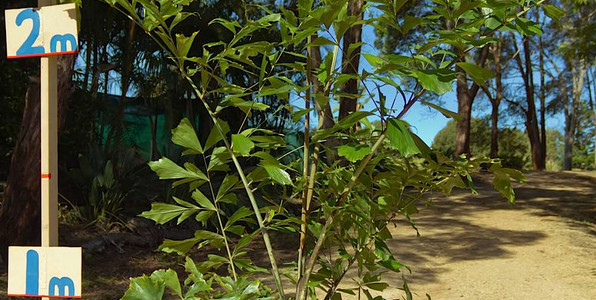Gallery
Click the thumbnails below to view image gallery:Fishtail palms are found from Cape York through SE Asia to China and India; they grow in rainforests of varying altitudes. The Australian Fishtail (Caryota albertii) is a climber and makes a good indoor palm. The Clustering Fishtail (Caryota mitis) is a spectacular palm for coastal Sydney and above in a protected place. When one trunk dies after seeding (as they do) there are lots more in its place.
Fishtail palms are wonderful additions to any garden or living space that can add a tropical island feel effortlessly. The leaves of the plant have jagged-edges that look like fins and fishtails, hence the name.
The Fishtail palms on average grow 6 to 8 metres tall and grow at a moderate pace if given the optimum environment. The Caryota cumingii grows to about 12 metres and the Caryota maxima grows to 30 metres. The Caryota no is also a giant amongst Fishtails growing to 25 metres and suited to tropical lowlands. These three probable do not make the best indoor plants.
Maintaining a Fishtail palm is relatively easy but can be time consuming. Here are some specifics on the basic requirements of this plant.
Sunlight
These palms can thrive in full or partial sunlight making it possible for you to place them beside or near taller palms or trees. They are also an ideal indoor plant because of their ability to grow with only moderate sun exposure.
To give this plant the best living conditions though, give it enough indirect sunlight exposure especially during the early morning and late afternoon. If you're growing it as an indoor plant, occasionally take it outside for air, cleaning and sunlight.
Water
If you're growing the Fishtail palm in a warmer climate, do not let the palm dry out as it will begin shedding leaves. The Fishtail also loves humidity. Simulate humidity by misting the leaves with lukewarm water every day or use a humidifier. Low humidity can cause the plant to yellow and slow down its growth.
Fertilizer
Feed your fishtail once a month, use an all-purpose liquid fertilizer for palms. It is advisable to apply the fertilizer after watering in order to avoid root burn which could be a death sentence to a Fishtail.
Over-feeding the plant can also be harmful and fatal if not remedied early. A sign of receiving too much fertilizer is withering of foliage. If this happens, halt fertilization and remove all damaged leaves. You can resume applying fertilizers again in 2 months.
Pruning
Pruning is a confusing procedure for palm owners. Some experts say that pruning should not be done externally and should be left to the palm while others say that pruning is essential in maintaining the proper health of a palm.
For Fishtail palms however, very little pruning is required for their maintenance. If you want to maintain their current height, cut the vertical stalks to just below the top fronds.
Pests and Diseases
Spider mites are the most common pest problem of the Fishtail. Take note if you see webs on your plant, check for spider mites. Toughly hose them off or Spray the plant with an insecticidal spray.
Another thing to look out for is the Pseudomonas disease, which affects the Fishtail species. You can spot this by looking for brown and wet lesions that usually run parallel to the leaf vein. Remove the infected leaves to stop the disease from spreading.
<< Previous Tips for Growing Magnificent Foxtail Palms (Wodyetia bifurcata) | Back to Tips for Growing Magnificent Foxtail Palms (Wodyetia bifurcata) | Next >> Caring For Your Kentia Palm (Howea forsteriana)







